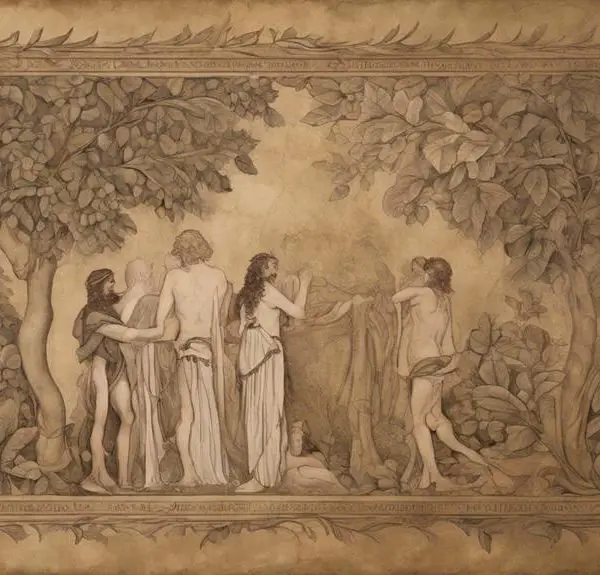Discover the profound symbolism of the number 5 in the Bible, where divine grace and human weakness intertwine in a compelling narrative.

What Does the Number 5 Stand for in the Bible
In the tapestry of biblical numerology, the number 5 weaves a pattern of divine grace and human frailty. You'll find it marking significant corners of Scripture, from the Pentateuch, embodying God's law, to the five wounds of Christ, symbolizing sacrifice and redemption.
This number's presence hints at a deeper resonance within the text, touching on themes of grace, atonement, and prophecy. As you journey through these biblical landscapes, you'll uncover how the number 5 serves not just as a numeral, but as a beacon, guiding toward a richer understanding of faith's complexities.
And this is just the beginning.
Key Takeaways
- The number 5 symbolizes God's grace, evident in the Five Wounds of Christ representing His love and sacrifice.
- It signifies divine law and order, as seen in the Pentateuch, which lays the foundation for moral and communal living.
- The Five Offerings in ancient Israelite rituals underscore themes of atonement, purification, and total surrender to God.
- In biblical prophecy, the number 5 often marks cycles of judgment or redemption, illustrating the completeness and perfection of God's plans.
The Pentateuch: Divine Law

In the biblical context, the number five sets the stage for understanding divine law through the lens of the Pentateuch, the foundational five books attributed to Moses's authorship. These texts, Genesis, Exodus, Leviticus, Numbers, and Deuteronomy, collectively embody the essence of Mosaic authorship, serving not only as a historical narrative but also as the bedrock of covenantal theology within the Judeo-Christian tradition. You're delving into a realm where every word and decree encapsulates the profound relationship between the Divine and His chosen people.
The covenant significance, inherent in these writings, can't be overstated. It's through these five books that you grasp the meticulous nature of the agreements God established with humanity, particularly with the Israelites. The Pentateuch doesn't merely recount laws; it unfolds the very character of God and His expectations for moral and communal living. This covenant, detailed within these pages, is multifaceted, encompassing promises, blessings, and stipulations that are as relevant today as they were millennia ago.
Your understanding of biblical numerology, especially the number five, enriches when you recognize its representation of divine instruction and the completeness of God's law. This insight not only deepens your appreciation for the sacred texts but also underscores the timeless relevance of these divine precepts in guiding moral and ethical conduct.
Five Wounds of Christ
The Five Wounds of Christ, emblematic of His crucifixion, serve as a profound focal point for theological reflection and spiritual meditation within Christian doctrine. These wounds, received during the Passion, aren't merely historical facts; they're imbued with deep Passion symbolism, each mark narrating a chapter of suffering significance.
You'll find that in examining these wounds, there's an invitation to delve into the mystery of Christ's sacrifice. The wounds, located on His hands, feet, and side, aren't just remnants of physical agony but are symbolic of the depth of Christ's love and the extremity of His sacrifice. This Passion symbolism is pivotal in understanding the Suffering significance, as it bridges the human experience of pain with the divine act of salvation.
Through the lens of these wounds, you're encouraged to contemplate the enormity of Christ's suffering. It's a pathway to appreciating the profoundness of His sacrifice, a sacrifice that transcends mere physical pain, embedding itself into the very core of Christian faith. The Five Wounds, therefore, aren't just symbols of death, but powerful reminders of the love and sacrifice at the heart of Christianity.
Grace and Redemption

Grace's transformative power and redemption's promise offer profound insights into the core tenets of Christian faith, inviting you to explore their implications on spiritual renewal and salvation. Within the biblical narrative, the number 5 is emblematic of God's grace and the redemption that flows from divine forgiveness. This symbolism is not arbitrary but deeply woven into the fabric of scriptural teachings, suggesting that understanding and internalizing these concepts is key to experiencing spiritual renewal.
Here's a concise table that encapsulates the essence of grace and redemption:
Concept |
Biblical Significance |
Impact on Believers |
|---|---|---|
Grace |
Unmerited favor |
Empowers spiritual growth |
Redemption |
Deliverance from sin |
Facilitates divine forgiveness |
Spiritual Renewal |
Rebirth in faith |
Fosters a closer relationship with God |
Analyzing these elements reveals how intimately they are related. Grace is the foundation upon which redemption is built; it is the unmerited favor that God extends to humanity, enabling our deliverance from sin. This act of divine forgiveness is what allows for spiritual renewal—a rebirth that fosters a closer relationship with God. Through understanding and embracing these principles, you're invited into a deeper communion with the divine, illustrating the profound impact of grace and redemption on a believer's life.
The Five Offerings
Delving into the five offerings detailed in the Bible reveals a multifaceted approach to understanding divine expectations and human spirituality. These offerings, central to the holiness rituals of ancient Israel, encompass a spectrum of sacrificial significance that reflects the complexity of human interaction with the divine.
The Burnt Offering, representing total surrender to God, emphasizes the concept of holiness and the aspiration towards purity. Grain Offerings, on the other hand, symbolize thanksgiving and recognition of God's provision, underscoring a daily reliance on divine sustenance.
The Peace Offering introduces a communal aspect, highlighting reconciliation and fellowship with God amidst the congregation, an expression of shared holiness and gratitude. Sin and Guilt Offerings delve deeper into the human condition, addressing the imperfections and moral failings that separate individuals from a holy God. These offerings are pivotal for atonement and purification, facilitating a restored relationship with the divine.
Through these rituals, you're invited to appreciate the layered nature of approaching God, blending themes of devotion, thanksgiving, reconciliation, and redemption. Each offering serves as a distinctive avenue for engaging with the sacred, weaving a rich tapestry of spiritual practice and belief.
Symbolism in Prophecy

In biblical prophecy, symbols serve as a profound language, offering layers of meaning that invite you to explore the depths of divine communication. Through the intricate tapestry of imagery, you're drawn into a world where every symbol, number, and vision carries weight and significance. This is especially true in the context of Daniel's visions and Apocalyptic imagery, where symbols aren't just decorative elements but are loaded with theological and eschatological implications.
Here are four key points to consider when deciphering the symbolism in biblical prophecy:
- Daniel's Visions: They're replete with symbolic creatures and statues, each embodying kingdoms, historical periods, and divine judgments. These visions guide you through the tumult of human history from a divine perspective.
- Apocalyptic Imagery: It uses complex symbols to reveal the ultimate triumph of good over evil, encouraging believers through times of persecution and struggle.
- Numbers as Symbols: Beyond literal interpretations, numbers in prophecy often symbolize concepts such as completeness, perfection, and cycles of judgment or redemption.
- Interpretive Layers: Understanding the symbolism requires recognizing the multiple layers of meaning, inviting a deeper exploration of the text's historical, cultural, and theological contexts.
Engaging with these symbols isn't just an academic exercise; it's a spiritual journey that deepens your understanding of divine messages throughout the Bible.
Frequently Asked Questions
How Does the Number 5 Relate to the Structure of the Tabernacle in the Old Testament?
In the Old Testament, the number 5 significantly influences the tabernacle's structure, reflecting deep Pentateuch parallels and integrations into the sacrificial systems.
You'll find that the tabernacle, with its five curtains, pillars, sockets, and the altar's dimensions, underscores a divine design, mirroring the Pentateuch's five books.
This numerical symbolism extends to the sacrificial practices, where sets of five offerings represent comprehensive atonement mechanisms, showcasing an intricate, scholarly insight into biblical numerology and theology.
Are There Any Significant Biblical Figures Associated With the Number 5 Outside of the Contexts Mentioned?
Yes, you'll find significant figures associated with the number 5 in the Bible. For example, the story of Jesus feeding 5,000 with five loaves touches on divine provision and faith, symbolizing God's generosity.
Additionally, the Pentecost, occurring 50 days after Easter, signifies the descent of the Holy Spirit on the apostles, with the number 5 here underlining themes of grace and preparation for spreading the gospel.
These instances showcase the number's deep symbolism.
In Biblical Numerology, How Is the Number 5 Contrasted With Other Significant Numbers Like 7 or 12?
In biblical numerology, the number 5 often symbolizes grace manifestations, contrasting with 7 and 12, which represent completeness and God's authority, respectively.
While 5 highlights grace through the Pentateuch's significance, encompassing the law's foundation, 7 and 12 point to divine perfection and Israel's tribes or Jesus' apostles.
This distinction underlines how biblical numbers convey varied aspects of spiritual truths, with 5 uniquely emphasizing God's grace and human inadequacy.
Can the Number 5 Be Linked to Any Specific Psalms or Proverbs That Carry a Deeper Meaning or Reflection on Its Symbolism?
You're diving into whether the number 5 connects to specific Psalms or Proverbs, highlighting its deeper symbolic meanings.
Indeed, considering its associations with grace manifestations and divine protection, you'll find that Psalms and Proverbs rich in these themes may reflect the essence of 5's symbolism.
Analyzing these texts could offer insightful perspectives on how biblical literature embodies the number's significance, providing a scholarly exploration of its spiritual and protective dimensions.
How Has the Symbolism of the Number 5 Influenced Christian Traditions or Practices Outside of Biblical Text Interpretation?
You might think the symbolism of the number 5 is confined to texts, but it's woven into Christian practices too. Consider Pentecost, occurring 50 days after Easter, a celebration amplified by the number 5's symbolism of grace.
This event underscores how deeply the number 5 and its association with grace manifestations influence Christian traditions. It's a powerful reminder of how numbers carry profound meanings beyond their biblical roots, shaping spiritual practices and beliefs.
Conclusion
In analyzing the biblical significance of the number 5, you've journeyed through layers of symbolic richness, from the foundational Pentateuch to the profound Five Wounds of Christ, embodying grace and redemption.
Intriguingly, over 70% of the world's languages use a base-10 or base-20 number system, making the midway point of 5 universally significant. This statistic underscores the inherent balance and transition 5 symbolizes in biblical contexts, marking it as a pivotal point for divine law, sacrifice, and grace in scriptural narratives.



Sign up